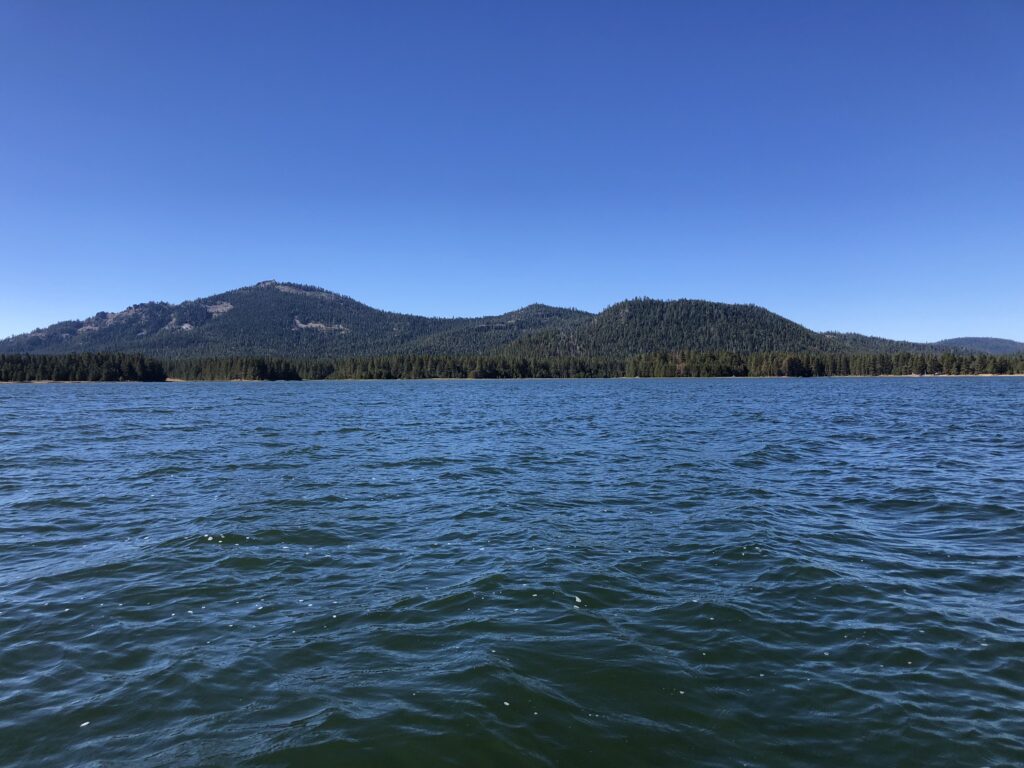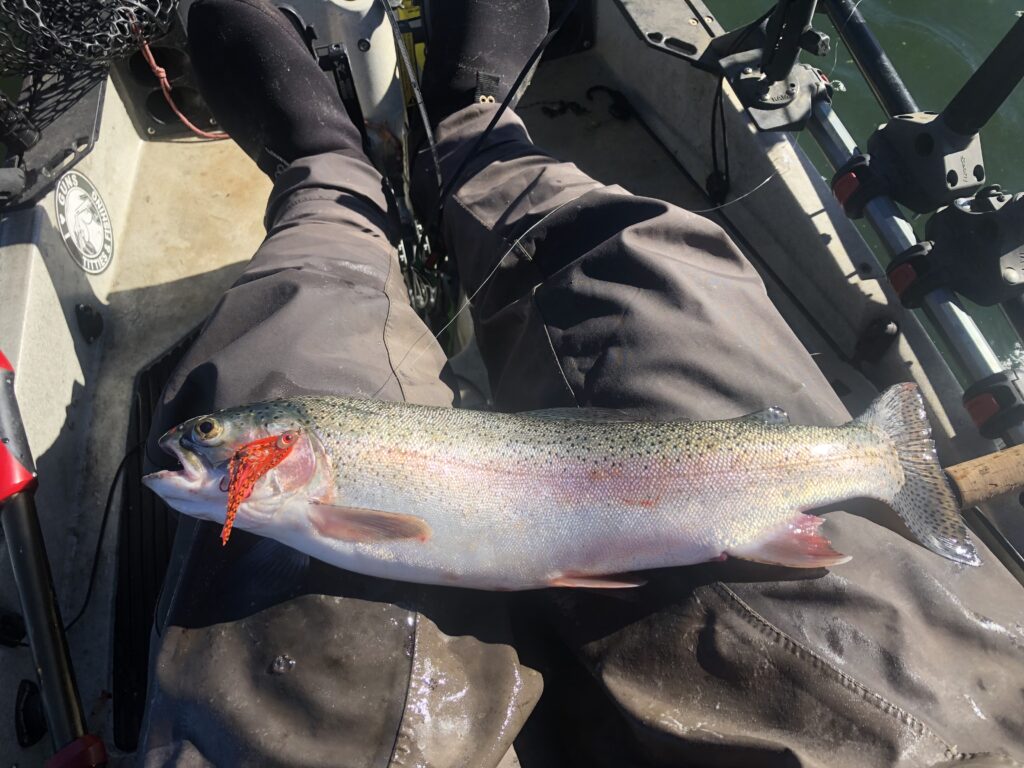Countdown To The Trout Opener: Plumas County Perfection At Lake Davis
We’re counting down to Saturday’s statewide trout opener with stories from our April trout preview issue. Today: Lake Davis is a Plumas County iconic trout destination.


By Cal Kellogg
Plumas County is blessed with some of California’s most exciting coldwater fisheries, including Bucks Lake with its browns, rainbows, Mackinaw and kokanee, and Lake Almanor, which boasts of trophy browns and rainbows, as well as bonus landlocked king salmon.
I spend a lot of time each year plying the waters of Plumas County and love fishing them all, but if I had to choose one as my all-time favorite, it would be Lake Davis. I’m sure some of the guys and gals reading this article are as enthusiastic about Lake Davis as I am, but there are likely just as many anglers who know nothing about the northern Sierra trout fishing jewel, so I’ll begin with a little history.
NONTRADITIONAL TROUT FISHERY
Lake Davis was formed in 1966 when the California State Water Project completed Grizzly Valley Dam, impounding the waters of Big Grizzly Creek, a tributary of the Middle Feather River. The lake, sitting at an elevation of 5,777 feet, is approximately 5 miles long and 2 miles wide. While the deepest spot, located near the dam, is just over 100 feet, the lake is shallow overall, averaging only 21 feet in depth.
When most West Coast anglers visualize a high Sierra trout lake, they imagine a deep, rocky, cold and clear body of water. Such lakes are typically nutrient deficient and support a trout population that is slow growing, with individual fish seldom reaching beyond the pan-size class.
Davis is a 180-degree contrast to what many perceive a mountain trout lake to be. Nutrient-rich meadow soil lining the bottom of the reservoir, combined with ample sun penetration due to the shallow average depth make for lots of vegetation growth.
This vegetation serves as habitat for a robust array of aquatic insects. The plants also release oxygen into the water, and this results in the exceptional fighting ability of the lake’s trout. The nutrient-laden water is less than clear. In fact, it can be downright murky, and this is a major advantage for anglers. I’ll explain more about this in a bit.
Fueled by a long list of insect species, including damselflies, dragonflies, mayflies and caddisflies, Lake Davis rainbows and browns grow quickly. As a result, it didn’t take long after its formation for the reservoir to gain notoriety as a trophy trout producer.
Throughout the 1970s, ’80s and early ’90s, anglers traveled long distances for a chance at battling Lake Davis’s big Eagle Lake-strain rainbows and German browns.
INVASIVE THREATS
During the 1996-97 season, the Lake Davis trout fishery was dealt a lethal blow when illegally introduced northern pike were discovered.
Fearing the pike would make it into the Feather River and spread to the Sacramento – where they would threaten salmon and steelhead populations – the California Department of Fish and Wildlife took action and poisoned the lake in an attempt to eliminate the pike.
No one knows whether the poisoning was unsuccessful or if more pike were illegally introduced into the lake afterwards, but by the early 2000s the pike population had rebounded. The state responded by lowering the lake level to better contain the pike and CDFW poisoned Davis once again in fall 2007.
The second round of poisoning brought the decade-long pike ordeal to an end. The pike were successfully eradicated, but the local economy in the town of Portola and the surrounding area, which relied on commerce generated by the trout fishery, was devastated.
Working with local shareholders, the state of California, Plumas County and CDFW worked hard to restore Lake Davis’s trout population.
BACK IN BUSINESS
Now, 17 years later, pike remain absent, Lake Davis is once again brimful of trout and the fishery is firing on all cylinders.
“I can’t say Davis is as good as it was in the late ’70s and ’80s when rainbows beyond 7 pounds were caught regularly, but in terms of the sheer number of trout present, it’s certainly one of the best trout lakes in the Sierra,” says longtime Lake Davis trout angler Jim Pleece. “These days, I catch big numbers of trout between 14 and 20 inches long on both fly and trolling gear. I’ve caught three fish right at the 5-pound mark over the past four years.”
While I can’t address the size of the trout Lake Davis produced back in the ’70s from first-hand experience, I agree with Pleece’s assertions about the present fishery. Fishing the lake extensively during both the spring and fall, I encounter big numbers of trout. Most of my catch consists of Eagle Lake-strain rainbows, but I’ve been hooking more and more browns in recent years.
When I visit Davis in the spring, I land a lot of trout in the 14- to 18-inch class. A two-day effort will generally produce something over 20 inches. In the fall, I hook more rainbows beyond 20 inches.
Lake Davis’s rainbows are great for eating and smoking. In the fall, I’ve landed many five-trout limits, and nothing in my cooler was under 20 inches. Like Pleece, the largest trout I’ve landed at Davis over the past several years have been rainbows flirting with the 5-pound mark.

HOOKING UP AT DAVIS
Back to Davis’s murky, nutrient-rich water. Over the years I’ve come to believe trout residing in stained water are easier to hook than their cousins living in clear water.
For example, the Eagle Lake-strain of rainbows in Davis are much easier to hook than the same strain at nearby Lake Almanor. Both lakes have a rich forage base and fast-growing trout, but Almanor has much clearer water.
I’ve come to believe it’s the clarity that makes Almanor ’bows harder to hook. I’m convinced diminished visibility sets the stage for murky-water trout to be ready strikers because they don’t have the luxury of scrutinizing your bait. I believe they feel the vibrations put off by the offering, move toward it, catch a flash of movement or color and strike. Fish on!
Lake Davis provides outstanding spring trout fishing for trollers, bank anglers and fly-fishing enthusiasts. The lake is basically oval in shape, the dam is located at the south end and there is a prominent island one-third of the way up from the dam. The north end and the area west of the island are made up of shallow weedy flats, and much of the nearshore water in these areas is very shallow.
These shallows hold a lot of trout. Fly anglers do well working these areas from prams and float tubes. Trollers can also score in these areas, but dealing with the weeds can be tricky and at times frustrating.

GO DEEPER
The reservoir’s deep water exists mainly in the southern two-thirds, east of the island. While fly anglers work the fringes of deep water, the depths of the lake offer the best opportunities for trollers and bank anglers. Trollers can work a wide swath of the water column with minimal interference from weeds, and bank anglers have access to deep water too.
I’ve spent hundreds of hours trolling the east side of Davis in my 14-foot pedal kayak. At times I’ve had exceptional luck pulling spoons and plugs. Typical lures such as Needlefish spoons, Yakima Bait Mag Lips and Trigger Spoon Juniors that can be trolled 1.8 to 2.5 mph work best. In stained water, orange, gold and pink lures offer consistent success.
When the trout are keying on insects, tiny spoons like Wee Dick Nites and Micro Trigger Spoons often work well in gold and brass patterns.
Year in and year out, my most productive offerings while trolling have been flies and soft plastic grubs from 2 to 3 inches long. I generally start out pulling flies and grubs in bright pink and orange colors, but there are days when more natural brown and olive hues outfish the bright stuff.

HEAT CHECK
Dialing in the color Lake Davis’s trout prefer on any given day is a matter of getting out on the water and taking the emotional temperature of the trout. Start with the bright stuff and if you aren’t getting good results, experiment with more subtle colors. From my observations, the bright stuff will pay off 80 percent of the time.
Bank anglers at Davis score well from the dam all the way up to the area near the Mallard Cove day-use/ boat launch area.
If you’re looking for a relaxing yet productive day of fishing while sitting in a chair and bathed in inspiring Northern Sierra scenery, PowerBait and inflated worms fished off the bottom are your poison.
Anglers who like to take a more active approach can achieve good results tossing small spoons such as gold Kastmasters and working Woolly Bugger flies teamed with a clear bobber.
I’ve found tossing the bugger and bobber to be exceptionally effective from shore, and at times I’ll utilize the rig for fan casting from my kayak.
One of my secrets for maximum success is using a 1-inch clear bobber and filling it completely with water. Not only does a full bobber cast like an artillery shell, but it also has neutral buoyancy, allowing you to count it down to work a bit deeper than you can with a bobber containing air.
As for the Woolly Buggers, sizes 6 and 8 work best. You’ll want offerings in olive, brown and black, but brighter patterns in orange, hot pink, chartreuse and even white can pay big dividends when the fish are in the mood for something that really stands out.
Fly anglers plying Lake Davis waters can hook up on a long list of patterns, but most of the time the action will come on subsurface patterns. If you have the patience for it, drifting small mayfly and caddis nymph imitations in size 14 and 16 under a strike indicator can be very effective.
I prefer to cast and strip for my fish, so I spend a lot of time tossing damsel nymph imitations, leech imitations and various Woolly Buggers in sizes 8 to 12.

WEATHER AND SEASONS
Winters are cold at Lake Davis and the lake typically freezes over. When the ice breaks in the spring, the fishing can be good for a few days, but then there is generally a slow period as the trout get accustomed to their now ice-free world.
The second half of April and the entire month of May offer exciting action for visiting anglers. Damselfly activity in June sets the stage for great fly fishing.
You can certainly hook fish at Lake Davis all summer, but I generally don’t fish the lake that time of year. After the spring action fades, I don’t return to the lake until the second half of October; I will fish until the snow flies in late November.
Wind should be on your mind anytime you visit Davis. The lake is wide open and the Sierra wind rushing to and from the Sacramento Valley to the west and the Great Basin to the east can really howl.
The trout generally bite very well during wind events, but you don’t want to be caught far from shore in a float tube, kayak or small boat when it’s blowing hard. If it’s too windy for you to navigate safely, don’t despair. Hit the east side of the lake with a bobber and bugger rig and you’ll likely smack some quality rainbows off the bank.
Remember that where we see waves and whitecaps, the rainbows see current. Rainbows love current, so when the wind is really pushing, they’ll pull up right under the chop to feed! CS



